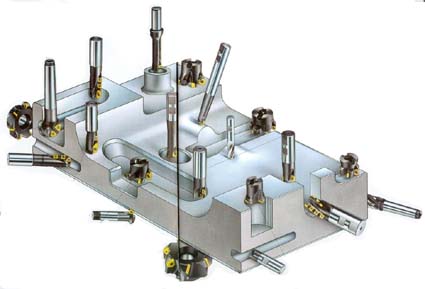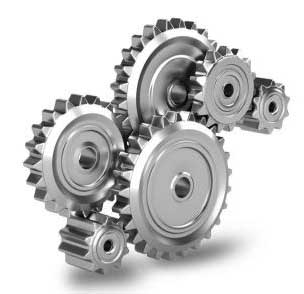Tool Heat Treatment Process for CNC Turning Titanium Alloy
The heat treatment process of titanium alloy processing tools is mostly periodic operation and is a collective operation. Therefore, there is a clear working limit in the heat treatment process. For example, quenching of a batch of parts may be completed by two shifts. Quenching and tempering are often completed by two shifts. In addition, the quality of the operators is uneven, the management measures are not perfect, and quality problems often occur in the production process. After a problem occurs, analyzing the problem and finding the cause is not only time-consuming, laborious, and sometimes impossible to find the real reason.
In the following, the author summarizes some ideas and methods for solving problems in the production site for many years, and provides some useful references for readers.

1. Carburized and quenched gears have low hardness
A batch of more than 800 pieces of gears that have been carburized and quenched in a Unicase drip-type gas carburizing and nitriding furnace in Japan require a surface hardness of 58 to 63 HRC after carburizing and quenching, but the surface hardness of the parts at the time of sampling is only 52 to 56 HRC. This is a carburizing problem or a quenching problem; Quenching is a heating problem or a cooling problem, and it is difficult to draw conclusions. Due to the urgent task of the production of these gears, the author took three pieces of the detected gears and bundled them with iron wire, reheated them in the salt bath furnace, and quenched and cooled in the oil tank. After about 30-40 minutes, the final quenching hardness was 63-65HRC. After reheating and quenching the gears, the twitch hardness is all qualified. This kind of quick and confusing method does not necessarily find out the real cause of the problem, but it solves the urgent need for production.
2. Bar material quenching crack
A batch of φ14mm×240mm 40Cr rod material after quenching and tempering. After about a week (when used), it was found that almost all of the bar material had cracks, and the crack shape was a longitudinal single crack, and most cracks cracked the both end faces of the bar. According to this, it is judged that the crack is a quenching crack, and the operator on duty does not recognize the responsibility. Check the operation record, only to find that the batch of bars is quenched in two shifts and tempered in three shifts. Process parameters such as part materials, quenching temperature and cooling medium are not recorded. The author took a bar and heated it in a salt bath furnace together with a 45 steel joint, and then quenched and cooled in brine. After cooling for about 20 to 30 minutes, the bar cracked and the crack shape was the same as the above crack shape. In the face of the facts, the operator admitted that it was mistaken to quench the batch of bar as 45 steel.
3. Box type resistance furnace annealing hardness is uneven
The pump shaft bar of the vane pump produced by our company is made of 38CrMoAlA. The process route is: annealing→ band saw cutting→roughing→tempering→finishing→grinding→nitriding. When the band saw is cut, it is often found that the hardness of the bar is uneven, the local hardness is high, the cutting efficiency is low, and the saw blade wears quickly. After analysis, it is because the bar is long or the bar is placed forward. There is no heating resistance wire at the mouth of the box type resistance furnace, and the heat loss is large. Therefore, for the general box type resistance furnace, the parts should be 200-300 mm from the inner side of the furnace mouth to ensure uniform heating temperature of the furnace parts.
4. Cast iron quenching should control trace alloying elements
Cast iron is thermally conductive. Poor, quenching and cooling are generally oil-cooled. The base of cast iron is the same as steel and is also composed of pearlite and ferrite. Cast iron has a high carbon content, although the increase in carbon content can increase the hardenability, but after all, the increase is not large. Therefore, to improve the hardenability of cast iron parts: the role of trace alloy elements in cast iron, to control the content of alloying elements, in order to ensure heat treatment quenching quality.
The vane pump stator produced by our company is made of wear-resistant alloy cast iron and requires heat treatment hardness of 50~56HRC. Since the content of alloying elements such as Cr, Mo, Mn and Sn in the casting is not well controlled, the hardness is uneven after heat treatment and quenching, and the hardness is low. It has been suggested that the low hardness after quenching is due to the fact that the proportion of pearlite in the as-cast matrix structure of the casting is small, and it is required to increase the normalizing process before quenching. Tests have shown that the castings are quenched after normalizing and the hardness is still low. In fact, under the same casting conditions, the proportion of pearlite in the as-cast matrix structure of the casting is related to the content of trace elements.

In the following, the author summarizes some ideas and methods for solving problems in the production site for many years, and provides some useful references for readers.

1. Carburized and quenched gears have low hardness
A batch of more than 800 pieces of gears that have been carburized and quenched in a Unicase drip-type gas carburizing and nitriding furnace in Japan require a surface hardness of 58 to 63 HRC after carburizing and quenching, but the surface hardness of the parts at the time of sampling is only 52 to 56 HRC. This is a carburizing problem or a quenching problem; Quenching is a heating problem or a cooling problem, and it is difficult to draw conclusions. Due to the urgent task of the production of these gears, the author took three pieces of the detected gears and bundled them with iron wire, reheated them in the salt bath furnace, and quenched and cooled in the oil tank. After about 30-40 minutes, the final quenching hardness was 63-65HRC. After reheating and quenching the gears, the twitch hardness is all qualified. This kind of quick and confusing method does not necessarily find out the real cause of the problem, but it solves the urgent need for production.
2. Bar material quenching crack
A batch of φ14mm×240mm 40Cr rod material after quenching and tempering. After about a week (when used), it was found that almost all of the bar material had cracks, and the crack shape was a longitudinal single crack, and most cracks cracked the both end faces of the bar. According to this, it is judged that the crack is a quenching crack, and the operator on duty does not recognize the responsibility. Check the operation record, only to find that the batch of bars is quenched in two shifts and tempered in three shifts. Process parameters such as part materials, quenching temperature and cooling medium are not recorded. The author took a bar and heated it in a salt bath furnace together with a 45 steel joint, and then quenched and cooled in brine. After cooling for about 20 to 30 minutes, the bar cracked and the crack shape was the same as the above crack shape. In the face of the facts, the operator admitted that it was mistaken to quench the batch of bar as 45 steel.
3. Box type resistance furnace annealing hardness is uneven
The pump shaft bar of the vane pump produced by our company is made of 38CrMoAlA. The process route is: annealing→ band saw cutting→roughing→tempering→finishing→grinding→nitriding. When the band saw is cut, it is often found that the hardness of the bar is uneven, the local hardness is high, the cutting efficiency is low, and the saw blade wears quickly. After analysis, it is because the bar is long or the bar is placed forward. There is no heating resistance wire at the mouth of the box type resistance furnace, and the heat loss is large. Therefore, for the general box type resistance furnace, the parts should be 200-300 mm from the inner side of the furnace mouth to ensure uniform heating temperature of the furnace parts.
4. Cast iron quenching should control trace alloying elements
Cast iron is thermally conductive. Poor, quenching and cooling are generally oil-cooled. The base of cast iron is the same as steel and is also composed of pearlite and ferrite. Cast iron has a high carbon content, although the increase in carbon content can increase the hardenability, but after all, the increase is not large. Therefore, to improve the hardenability of cast iron parts: the role of trace alloy elements in cast iron, to control the content of alloying elements, in order to ensure heat treatment quenching quality.
The vane pump stator produced by our company is made of wear-resistant alloy cast iron and requires heat treatment hardness of 50~56HRC. Since the content of alloying elements such as Cr, Mo, Mn and Sn in the casting is not well controlled, the hardness is uneven after heat treatment and quenching, and the hardness is low. It has been suggested that the low hardness after quenching is due to the fact that the proportion of pearlite in the as-cast matrix structure of the casting is small, and it is required to increase the normalizing process before quenching. Tests have shown that the castings are quenched after normalizing and the hardness is still low. In fact, under the same casting conditions, the proportion of pearlite in the as-cast matrix structure of the casting is related to the content of trace elements.






